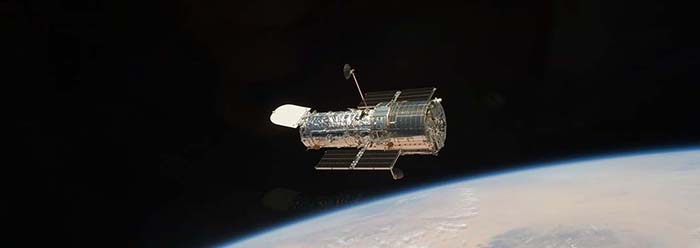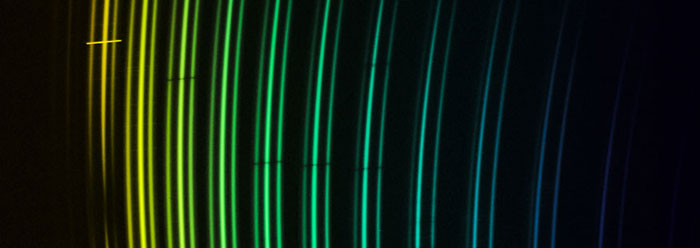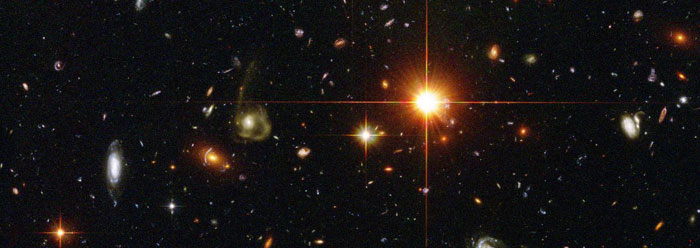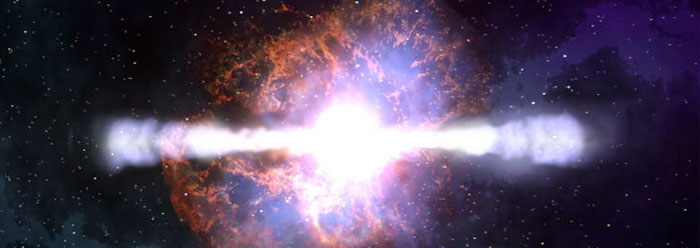Key features in a newly discovered distant galaxy produce a puzzle for nature-only origins.
NASA’s Hubble Space Telescope imaged the oddity, named MACS2129-1. Sune Toft, Associate Professor at the Niels Bohr Institute of the University of Copenhagen, led a research team that accessed Hubble to investigate this out-of-place galaxy.1 Toft’s team published details in Nature.2
Gravity from an in-between cluster of galaxies effectively magnified (by a factor of 4.6) the light from MACS2129-1. This natural magnification distorted, but enlarged, the galaxy’s image enough to reveal its mixture of unexpected features.
This galaxy rotates like a spiral galaxy, even though it has few blue stars that typify spiral galaxies. Since secular physicists assume a billions-of-years-old universe, they attribute short-lived blue stars to recent, natural formation—but so far no one has actually observed star formation. In contrast, Genesis one says that God made the stars on Day four then finished crafting the world a few days later.
Elliptical galaxies typically have very few blue stars, whereas the arms of spiral galaxies tend to have many. So scientists who believe in active star formation assume that few stars form in rounded, elliptical, non-blue galaxies. Toft told the Niels Bohr Institute News, “Here [in elliptical galaxies] the stars seem to be all over the place, to move in all directions. And that was what we expected to find when we took a closer look at MACS2129-1.” But instead they found a first: A spiral galaxy with virtually no blue stars—a “dead” galaxy.
And this dead galaxy spins strangely fast. The team showed evidence that when compared to our Milky Way galaxy, MACS2129-1 has three times the mass, half the size, and yet spins more than twice as fast at over 500 km per second.1
How could the same set of natural circumstances produce such radically different galaxies?
Niels Bohr Institute News said, “The finding is remarkable, as this pattern of stellar rotation in a dead galaxy strongly contradicts prevalent astrophysical theory regarding the formation of elliptical-shaped galaxies shortly after the Big Bang 13.7 billion years ago.”
How often have astronomical discoveries strongly contradicted prevalent astrophysical (read: stellar evolutionary) theory? Simply peruse articles listed on the ICR topic page, “The Universe Was Created Powerfully” to see just a few of the many observations that keep contradicting secular theories about outer space.3
Secular scientists theorize that destructive collisions formed planets and moons, unseen clouds supply the comets we see today, hypothetical density waves formed galactic arms, unobserved dynamos regenerate magnetic fields in Earth and other planets, unobserved collapsing gas clouds formed solar systems and blue stars, and the universe emerged from nothing. But all of these ideas collide with new discoveries. MACS2129-1 marks the latest finding that shows God’s apparently whimsical creativity.
How can a distant, fast-winding, spiral galaxy without blue stars exist in a universe supposedly filled with random unintentional objects? By God’s intentional originality.
References
- Larsen, H. Unexpected rotation in a stone-dead galaxy. Niels Bohr Institute News. Posted on nbi.ku.dk June 20, 2017, accessed June 26, 2017.
- Toft, S., et al. 2017. A massive, dead disk galaxy in the early Universe. Nature. 546(7659): 510-513.
- The Universe Was Created Powerfully. Posted on ICR.org, accessed June 26, 2017.
*Mr. Thomas is Science Writer at the Institute for Creation Research and earned his M.S. in biotechnology from Stephen F. Austin State University..
Article posted on July 10, 2017.

























